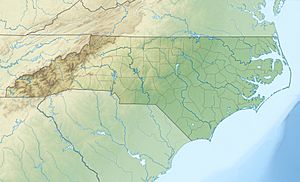Big Branch (Lanes Creek tributary) facts for kids
Quick facts for kids Big Branch |
|
|---|---|
|
Location of Big Branch mouth
|
|
| Other name(s) | Tributary to Lanes Creek |
| Country | United States |
| State | North Carolina |
| County | Anson |
| Physical characteristics | |
| Main source | Cribs Creek divide about 2 miles southeast of Fountain Hill, North Carolina 440 ft (130 m) 35°03′58″N 080°15′01″W / 35.06611°N 80.25028°W |
| River mouth | Lanes Creek about 2 miles north of Griffins Crossroads, North Carolina 318 ft (97 m) 35°02′17″N 080°15′01″W / 35.03806°N 80.25028°W |
| Length | 3.33 mi (5.36 km) |
| Basin features | |
| Progression | generally southeast |
| River system | Pee Dee River |
| Basin size | 4.62 square miles (12.0 km2) |
| Tributaries |
|
| Bridges | Tucker Road, Bowers Road, Kiker Road, Birmingham Road |
Big Branch is a small stream, about 3.33 mi (5.36 km) long, located in Anson County, North Carolina. It is a tributary, which means it's a smaller stream that flows into a larger one. Big Branch flows into Lanes Creek.
Contents
The Journey of Big Branch
Big Branch begins its journey about 2 miles (3.2 km) southeast of a place called Fountain Hill, North Carolina. It starts at an elevation of about 440 ft (130 m) (134 meters) above sea level.
Where it Flows
From its starting point, Big Branch generally flows towards the southeast. It travels through the landscape of Anson County.
Joining Lanes Creek
After flowing for about 3.33 mi (5.36 km), Big Branch reaches its end. It joins Lanes Creek about 2 miles (3.2 km) north of Griffins Crossroads. At this meeting point, the elevation is about 318 ft (97 m) (97 meters).
Understanding the Watershed
A watershed is like a big bowl or area of land where all the rain and snowmelt drain into a common stream, river, or lake. The Big Branch watershed is the entire area of land that collects water and sends it into Big Branch.
Size and Environment
The Big Branch watershed covers an area of about 4.62 square miles (12.0 km2) (11.97 km²). This area gets a good amount of rain each year, around 48.0 inches (122 cm). A large part of this watershed, about 60%, is covered by forests. This means there are many trees that help keep the water clean and the soil healthy.



